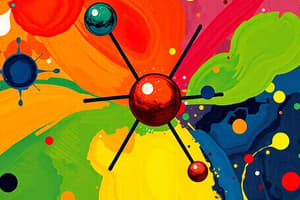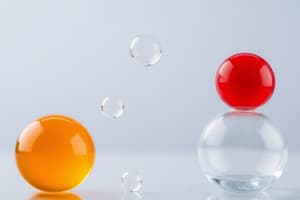Podcast
Questions and Answers
What defines a cation?
What defines a cation?
- It has a positive charge due to proton gain.
- It has a positive charge due to electron loss. (correct)
- It has a neutral charge with equal protons and electrons.
- It has a negative charge due to electron gain.
What results in the formation of an anion?
What results in the formation of an anion?
- The atom gains neutrons.
- The atom loses protons.
- The atom gains electrons. (correct)
- The atom loses electrons.
Which of the following correctly describes an atom in a neutral state?
Which of the following correctly describes an atom in a neutral state?
- More protons than neutrons.
- Equal numbers of protons and electrons. (correct)
- More electrons than protons.
- Equal numbers of protons and neutrons.
What is the primary structure of an atom responsible for its positive charge?
What is the primary structure of an atom responsible for its positive charge?
Which of the following is an example of a cation-forming element?
Which of the following is an example of a cation-forming element?
What occurs when an atom gains electrons?
What occurs when an atom gains electrons?
What type of ion is formed by the loss of one or more electrons?
What type of ion is formed by the loss of one or more electrons?
Which subatomic particle is not charged?
Which subatomic particle is not charged?
What is a common method for cation formation?
What is a common method for cation formation?
Why do ions have a net electrical charge?
Why do ions have a net electrical charge?
What happens to a sodium atom when it loses one electron?
What happens to a sodium atom when it loses one electron?
Which element commonly forms anions by gaining electrons?
Which element commonly forms anions by gaining electrons?
What does the octet rule state about atom behavior?
What does the octet rule state about atom behavior?
What is formed when a cation and an anion interact?
What is formed when a cation and an anion interact?
Which characteristic is typical of ionic compounds?
Which characteristic is typical of ionic compounds?
Why do ionic compounds conduct electricity when dissolved in water?
Why do ionic compounds conduct electricity when dissolved in water?
What charge does a chloride ion have after gaining one electron?
What charge does a chloride ion have after gaining one electron?
Which of the following statements about cations is correct?
Which of the following statements about cations is correct?
What is a characteristic of ionic bonds?
What is a characteristic of ionic bonds?
Which ionic compound is commonly known as table salt?
Which ionic compound is commonly known as table salt?
Flashcards
Cation
Cation
A positively charged ion formed when an atom loses electrons.
Anion
Anion
A negatively charged ion formed when an atom gains electrons.
Ionic bond
Ionic bond
Electrostatic attraction between oppositely charged ions.
Octet rule
Octet rule
Signup and view all the flashcards
Sodium cation
Sodium cation
Signup and view all the flashcards
Chloride anion
Chloride anion
Signup and view all the flashcards
Electrical neutrality
Electrical neutrality
Signup and view all the flashcards
High melting point
High melting point
Signup and view all the flashcards
Solubility in water
Solubility in water
Signup and view all the flashcards
Electrical conductivity
Electrical conductivity
Signup and view all the flashcards
Ionic compound
Ionic compound
Signup and view all the flashcards
Electron
Electron
Signup and view all the flashcards
Proton
Proton
Signup and view all the flashcards
Atom
Atom
Signup and view all the flashcards
Outer electron shell
Outer electron shell
Signup and view all the flashcards
Noble gas
Noble gas
Signup and view all the flashcards
Sodium
Sodium
Signup and view all the flashcards
Chlorine
Chlorine
Signup and view all the flashcards
Chemical reaction
Chemical reaction
Signup and view all the flashcards
Radiation
Radiation
Signup and view all the flashcards
Study Notes
Cations and Anions
- Cations are positively charged ions formed when an atom loses one or more electrons.
- Anions are negatively charged ions formed when an atom gains one or more electrons.
- The charge on an ion is determined by the imbalance between protons (positive) and electrons (negative).
Formation of Cations and Anions
- Atoms are electrically neutral when they have an equal number of protons and electrons.
- Cations form when atoms lose electrons due to chemical reactions, radiation, or electrical currents.
- For example, Sodium (Na) loses one electron to become a sodium cation (Na⁺) with a +1 charge.
- Anions form when an atom gains electrons due to chemical reactions or interactions with other charged particles.
- For example, Chlorine (Cl) gains one electron to become a chloride anion (Cl⁻) with a -1 charge.
The Octet Rule
- The octet rule states that atoms tend to gain, lose, or share electrons to achieve a full outer electron shell, typically containing eight electrons.
- This configuration is energetically favorable and often observed in noble gases like neon and argon.
- Atoms with fewer than four electrons in their outer shell tend to lose electrons to achieve a full outer shell, forming cations.
- Atoms with more than four electrons in their outer shell tend to gain electrons to fill the shell, forming anions.
Ionic Bonds
- Ionic bonds are strong electrostatic forces of attraction between oppositely charged ions.
- They typically form between metals (which tend to lose electrons and become cations) and non-metals (which tend to gain electrons and become anions).
- Example: Sodium chloride (NaCl) is an ionic compound formed by the attraction between Na⁺ and Cl⁻.
Properties of Ionic Compounds
- High Melting and Boiling Points due to strong ionic bonds.
- Solubility in Water as ions separate and disperse in solution, making it conductive.
- Electrical Conductivity when dissolved in water or melted, as ions are free to move.
Studying That Suits You
Use AI to generate personalized quizzes and flashcards to suit your learning preferences.




